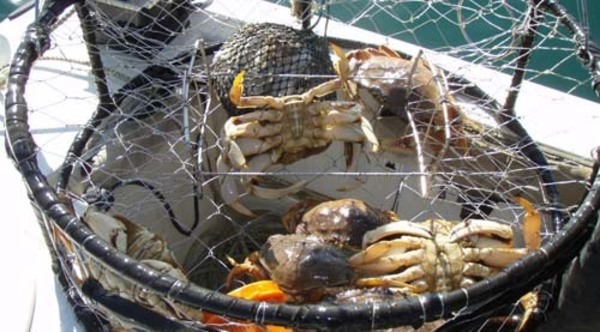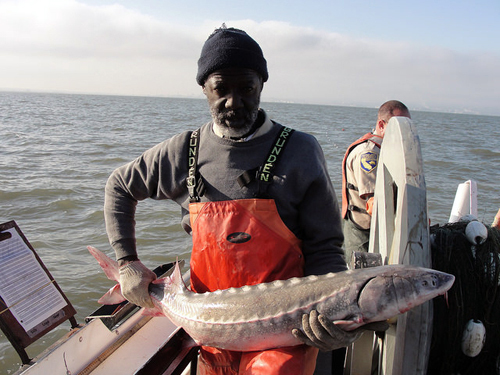Crab Open

by California Department of Fish & Wildlife
3-19-2016
Website
Closure of the recreational Dungeness crab fishery south of the Mendocino/Sonoma county line has been lifted, and opening of the commercial Dungeness crab fishery – delayed since November – is set for March 26 in the same region.
Recent test results show that domoic acid levels in crabs off the California coast south of the Mendocino/Sonoma county line no longer pose a significant human health risk, according to notice given today to the California Department of Fish and Wildlife (CDFW) and the Fish and Game Commission (Commission) by the director of the Office of Environmental Health Hazard Assessment (OEHHA), after consultation with the Director of the California Department of Public Health (CDPH).
As a result, the director of OEHHA recommends opening the Dungeness crab fishery in this area. Under emergency closure regulations, CDFW will provide commercial Dungeness crab fishermen at least seven days’ notice before the re-opening of the commercial fishery south of the Mendocino/Sonoma county line, and so that fishery will open at 12:01 a.m. Saturday, March 26. The presoak period, during which commercial fishermen may begin getting gear in place, starts at 6:01 a.m. Friday, March 25.
Closures remain in place north of the Mendocino/Sonoma county line for the Dungeness crab commercial and recreational fisheries. The commercial and recreational rock crab fisheries are closed north of Piedras Blancas Light Station near San Simeon, and in state waters around San Miguel, Santa Rosa and Santa Cruz islands.
The unusually high domoic acid levels off the coast this fall and winter wrecked a Dungeness crab fishery worth as much as $90 million a year to California’s economy. Domoic acid is a potent neurotoxin that can accumulate in shellfish, other invertebrates and sometimes fish. At low levels, domoic acid exposure can cause nausea, diarrhea and dizziness in humans. At higher levels, it can cause persistent short-term memory loss, seizures and may be fatal.
“This has been a very difficult season for hardworking Californians who have suffered significant financial hardship due to this natural disaster,” said Charlton H. Bonham, Director of CDFW. “We thank the affected communities for their patience and fortitude as we have worked with our partners at CDPH and OEHHA to open a portion of the commercial fishery along a traditional management boundary as recommended by the industry.”
Both the commercial and recreational Dungeness crab seasons are scheduled to end June 30 in the newly opened area, although the CDFW director has authority to extend the commercial season.
In February, Governor Edmund G. Brown Jr. sent a letter to U.S. Secretary of Commerce Penny Pritzker seeking federal declarations of a fishery disaster and a commercial fishery failure in response to the continued presence of unsafe levels of domoic acid and the corresponding closures of rock crab and Dungeness crab fisheries across California. Should a federal determination be made to declare a disaster and failure, the state and federal agencies will work together to determine the full economic impact of the disaster and, upon appropriation of funds from Congress, provide economic relief to affected crabbers and related businesses.
Despite several weeks of test results that showed crab body meat samples below alert levels, one sample of viscera was slightly above the alert level. Because of this, CDPH and OEHHA strongly recommend that anglers and consumers not eat the viscera (internal organs, also known as “butter” or “guts”) of crabs. CDPH and OEHHA are also recommending that water or broth used to cook whole crabs be discarded and not used to prepare dishes such as sauces, broths, soups or stews. The viscera usually contain much higher levels of domoic acid than crab body meat. When whole crabs are cooked in liquid, domoic acid may leach from the viscera into the cooking liquid. This is being recommended to avoid harm in the event that some crabs taken from an open fishery have elevated levels of domoic acid.
With the partial opening of the commercial fishery in the state, CDFW recommends that all people fishing for crab refer to the Best Practices Guide, a resource providing tips on how to use crab trap gear in a manner that reduces incidences of whale entanglements. This guide was produced collaboratively between commercial crabbers, agency staff and staff from non-profit organizations during two meetings of the Dungeness Crab Fishing Gear Working Group that took place late last year.
Pursuant to the emergency regulations adopted by the Commission and CDFW on November 5 and 6, 2015, respectively, the current open and closed areas are as follows:
Areas open to crab fishing include:
• Recreational Dungeness crab fishery along mainland coast south of Sonoma/Mendocino county line – 38° 46.1’ N Latitude, near Gualala, Mendocino County
• On March 26, 2016 Commercial Dungeness crab fishery along mainland coast south of Sonoma/Mendocino county line – 38° 46.1’ N Latitude, near Gualala, Mendocino County
• Commercial and recreational rock crab fishery along the mainland coast south of 35° 40′ N Latitude (Piedras Blancas Light Station, San Luis Obispo County)
Areas closed to crab fishing include:
• Recreational Dungeness crab fishery north of Sonoma/Mendocino county line – 38° 46.1’ N Latitude, near Gualala, Mendocino County
• Commercial Dungeness crab fishery north of Sonoma/Mendocino county line – 38° 46.1’ N Latitude, near Gualala, Mendocino County
• Commercial and recreational rock crab fisheries north of 35° 40′ N Latitude (Piedras Blancas Light Station) • Commercial and
recreational rock crab fisheries in state waters around San Miguel, Santa Rosa and Santa Cruz Islands.
CDFW will continue to closely coordinate with CDPH, OEHHA and fisheries representatives to extensively monitor domoic acid levels in Dungeness and rock crabs to determine when the fisheries can safely be opened throughout the state.
Recent test results show that domoic acid levels in crabs off the California coast south of the Mendocino/Sonoma county line no longer pose a significant human health risk, according to notice given today to the California Department of Fish and Wildlife (CDFW) and the Fish and Game Commission (Commission) by the director of the Office of Environmental Health Hazard Assessment (OEHHA), after consultation with the Director of the California Department of Public Health (CDPH).
As a result, the director of OEHHA recommends opening the Dungeness crab fishery in this area. Under emergency closure regulations, CDFW will provide commercial Dungeness crab fishermen at least seven days’ notice before the re-opening of the commercial fishery south of the Mendocino/Sonoma county line, and so that fishery will open at 12:01 a.m. Saturday, March 26. The presoak period, during which commercial fishermen may begin getting gear in place, starts at 6:01 a.m. Friday, March 25.
Closures remain in place north of the Mendocino/Sonoma county line for the Dungeness crab commercial and recreational fisheries. The commercial and recreational rock crab fisheries are closed north of Piedras Blancas Light Station near San Simeon, and in state waters around San Miguel, Santa Rosa and Santa Cruz islands.
The unusually high domoic acid levels off the coast this fall and winter wrecked a Dungeness crab fishery worth as much as $90 million a year to California’s economy. Domoic acid is a potent neurotoxin that can accumulate in shellfish, other invertebrates and sometimes fish. At low levels, domoic acid exposure can cause nausea, diarrhea and dizziness in humans. At higher levels, it can cause persistent short-term memory loss, seizures and may be fatal.
“This has been a very difficult season for hardworking Californians who have suffered significant financial hardship due to this natural disaster,” said Charlton H. Bonham, Director of CDFW. “We thank the affected communities for their patience and fortitude as we have worked with our partners at CDPH and OEHHA to open a portion of the commercial fishery along a traditional management boundary as recommended by the industry.”
Both the commercial and recreational Dungeness crab seasons are scheduled to end June 30 in the newly opened area, although the CDFW director has authority to extend the commercial season.
In February, Governor Edmund G. Brown Jr. sent a letter to U.S. Secretary of Commerce Penny Pritzker seeking federal declarations of a fishery disaster and a commercial fishery failure in response to the continued presence of unsafe levels of domoic acid and the corresponding closures of rock crab and Dungeness crab fisheries across California. Should a federal determination be made to declare a disaster and failure, the state and federal agencies will work together to determine the full economic impact of the disaster and, upon appropriation of funds from Congress, provide economic relief to affected crabbers and related businesses.
Despite several weeks of test results that showed crab body meat samples below alert levels, one sample of viscera was slightly above the alert level. Because of this, CDPH and OEHHA strongly recommend that anglers and consumers not eat the viscera (internal organs, also known as “butter” or “guts”) of crabs. CDPH and OEHHA are also recommending that water or broth used to cook whole crabs be discarded and not used to prepare dishes such as sauces, broths, soups or stews. The viscera usually contain much higher levels of domoic acid than crab body meat. When whole crabs are cooked in liquid, domoic acid may leach from the viscera into the cooking liquid. This is being recommended to avoid harm in the event that some crabs taken from an open fishery have elevated levels of domoic acid.
With the partial opening of the commercial fishery in the state, CDFW recommends that all people fishing for crab refer to the Best Practices Guide, a resource providing tips on how to use crab trap gear in a manner that reduces incidences of whale entanglements. This guide was produced collaboratively between commercial crabbers, agency staff and staff from non-profit organizations during two meetings of the Dungeness Crab Fishing Gear Working Group that took place late last year.
Pursuant to the emergency regulations adopted by the Commission and CDFW on November 5 and 6, 2015, respectively, the current open and closed areas are as follows:
Areas open to crab fishing include:
• Recreational Dungeness crab fishery along mainland coast south of Sonoma/Mendocino county line – 38° 46.1’ N Latitude, near Gualala, Mendocino County
• On March 26, 2016 Commercial Dungeness crab fishery along mainland coast south of Sonoma/Mendocino county line – 38° 46.1’ N Latitude, near Gualala, Mendocino County
• Commercial and recreational rock crab fishery along the mainland coast south of 35° 40′ N Latitude (Piedras Blancas Light Station, San Luis Obispo County)
Areas closed to crab fishing include:
• Recreational Dungeness crab fishery north of Sonoma/Mendocino county line – 38° 46.1’ N Latitude, near Gualala, Mendocino County
• Commercial Dungeness crab fishery north of Sonoma/Mendocino county line – 38° 46.1’ N Latitude, near Gualala, Mendocino County
• Commercial and recreational rock crab fisheries north of 35° 40′ N Latitude (Piedras Blancas Light Station) • Commercial and
recreational rock crab fisheries in state waters around San Miguel, Santa Rosa and Santa Cruz Islands.
CDFW will continue to closely coordinate with CDPH, OEHHA and fisheries representatives to extensively monitor domoic acid levels in Dungeness and rock crabs to determine when the fisheries can safely be opened throughout the state.
More Reports

3-14-2016
The California Department of Fish and Wildlife (CDFW) is reminding sturgeon anglers to return their 2015 Sturgeon Fishing Report Cards...... Read More
California Department of Fish & Wildlife Reports
for Thursday, March 10th, 2016• Abandoned lobster traps and hoop nets
• If duck hasn’t built a nest yet, can I catch and eat it?
• Fishing and trapping crayfish at the same time
